Tom’s Vashon Rocketry Site
| Return to My Fleet |  |
Vanir My Vanir design is a cold-power helicopter recovery model—something which has never been done before to my knowledge. The model is powered by a Vashon V-2 motor and can fly to about 120 feet before deploying its rotors and spinning back to the ground. The main body tube is Centuri-sized ST-10 (available from Semroc). The V-2 motor slip fits tightly into the tube from the rear. The nose cone is balsa and is held in place with three small nails which are covered with yellow tape in the photo (this allows the nose to be removed so that the internal piston can be removed if needed—see picture below). The rotor design of the Vanir is based on an inverted George Gassaway's Rotaroc helicopter design. The rotors are made of 3/32" balsa covered in Monokote, and are held in place with DuBro RC airplane hinges. The rotors are held closed during boost phase by three 1/16" plywood "hooks" that are attached to the internal piston. The piston, made of ST-9 tube, slides inside the ST-10 body with the hold down hooks protruding through slots in the ST-10. The piston is spring loaded. It is pushed back onto the top of the V-2 motor's separator before the motor is pressurized, and the separator grips the piston tube and holds it in the rearward position. After launch, when the pressure in the separator drops, the piston is released and its internal spring pushes it forward, releasing the rotors. Elastic bands at the rear of the rotors pull them open (the elastic bands attach to hook pins on the rotor stops at on end, and hook around the motor's nozzle at the other end. The rotors are tilted and airfoiled to cause rotation and lift during the recovery phase. Unlike in the standard Rotaroc design, the rotor stops (which also serve as standoffs to give the elastic bands more leverage) are at the rear of the rocket, so they improve the stability of the model rather that being detrimental to the stability. Also, the tension required on the elastic bands is less than what's needed in a Rotaroc because the airflow past the model will help open the rotors. The fins of the Vanir are a slightly oversized version of the Vashon "No. 1" fin planform made from 3/32" balsa and Monokoted. The hole in the ST-10 tube that allows access to the fuel filling valve of the V-2 motor is alongside one fin near the pivot end of a rotor. A small cutout in one corner of the rotor allows access to the filling valve. The vent valve hole can be reached by a bent safety pin through the gap between two rotors. Note that the internal piston tube mates directly to the separator of the V-2 motor; there is no aluminum ring as normally used where a parachute tube attaches to a separator. I found that by soaking the end of the ST-9 paper tube with thin cyanoacrylate adhesive, and gluing a coupler tube 1/8" inside the end of the ST-9, the tube is sufficiently stiff and strong that the separator can grip it securely without deforming or damaging it. In Norse mythology, the Vanir was one of the two pantheons of gods that dwelt in Asgard, the other and more well known being the Æsir.
|

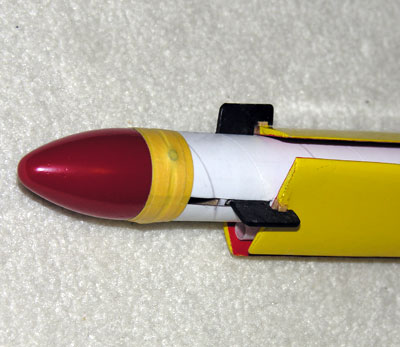
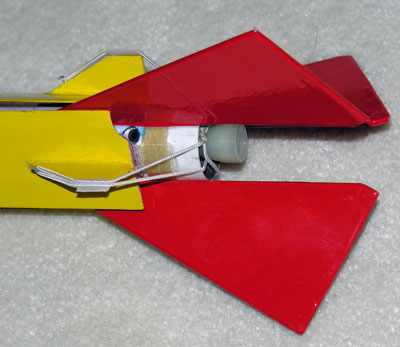
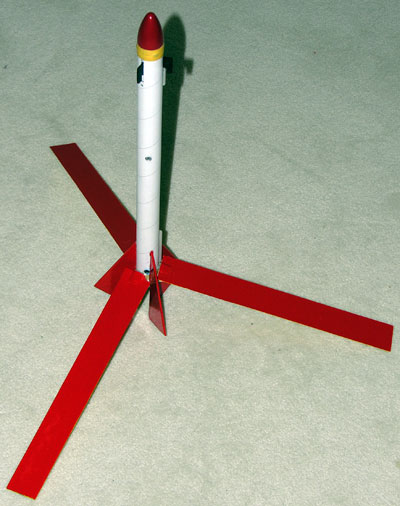
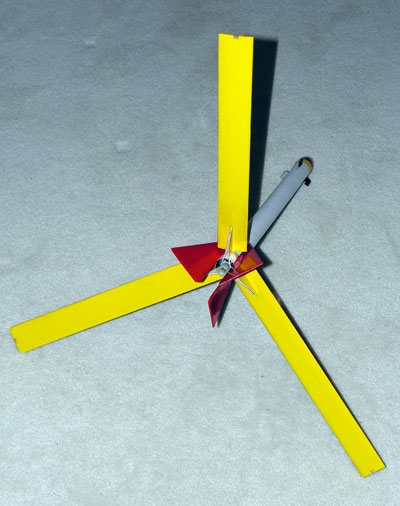
Vanir was flown at the June and July 2007 sport launches of the Zia Spacemodelers rocket club. On its first flight, one of the rotors broke off on deployment—the plastic DuBro hinge broke. I've never seen hinges fail that way on competition Rotarocs—they usually fail by coming loose from the blade or body instead of breaking the plastic—but I've always used Klett hinges before, and not DuBro. Perhaps the Dubro hinges have weaker plastic. Surprisingly, even with one rotor missing, the model began to rotate and was soon spinning very rapidly in a nose-down vertical orientation—just the way it was supposed to work.
For its second flight, the Vanir's rotor was reattached and limit lines were added to the rotors help take up the shock of the blades opening. A longer delay was used (two timer disks instead of one). This time the deployment was perfect and the Vanir descended by autogyro recovery on all three blades. Oddly, the model displayed a a larger precession effect than it did with only two blades (although the gustier wind conditions may have had something to do with this).

![]()

![]()
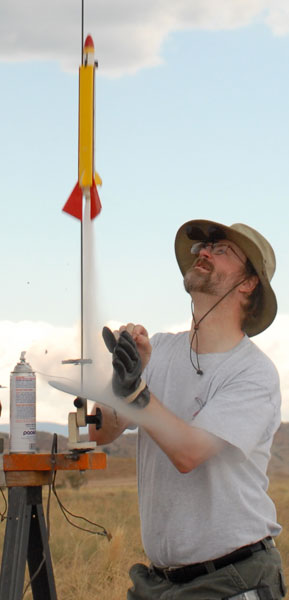
![]()
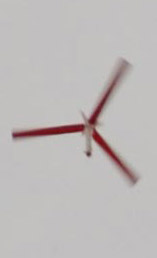
Above — left two photos: Flight #1 liftoff and recovery on two rotors (photos by Mark Hamilton).
Above — right two photos: Flight #2 liftoff and rotors deployed high overhead (photos by Meghan Wilson).
Below: After Flight #2. Note the limit line on the deployed rotor (photo by Meghan Wilson).
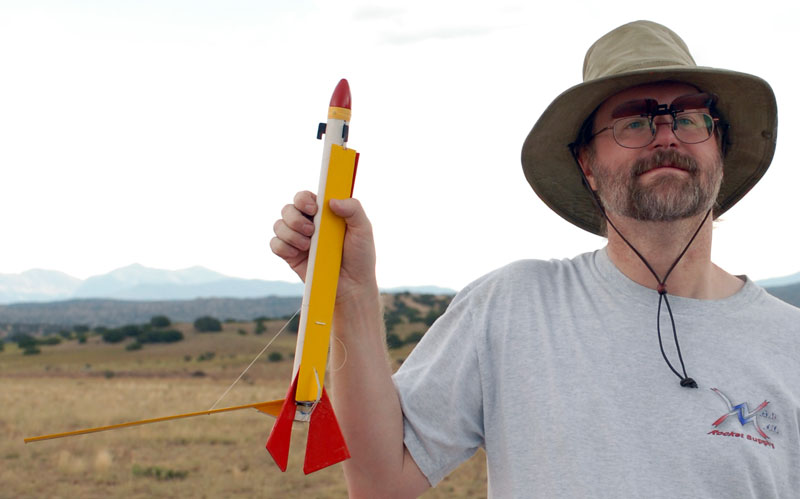
Page last updated July 19, 2007
